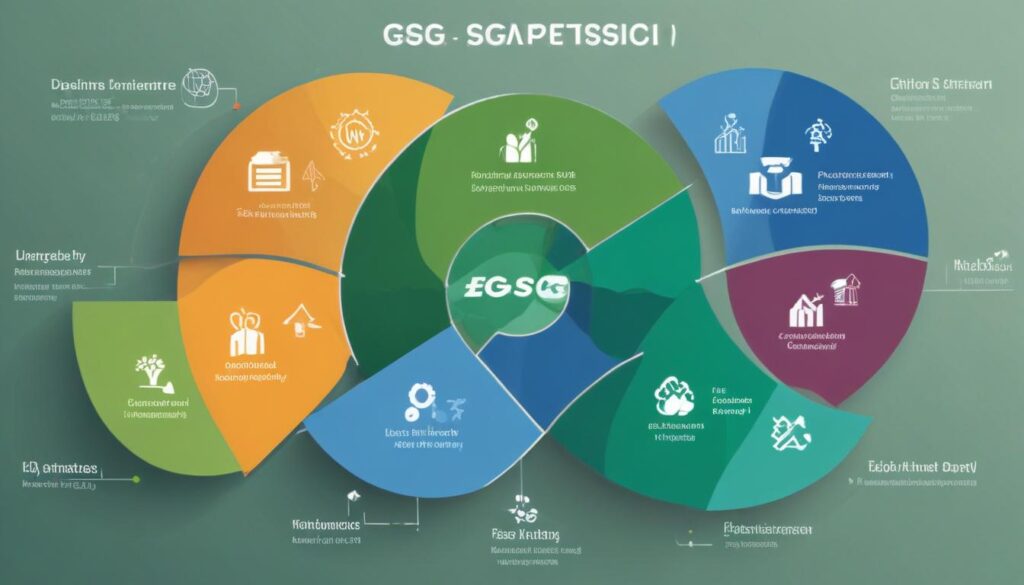To create the best ESG reports that investors trust, organizations must ensure transparency, accountability, and stakeholder engagement while adhering to regulatory standards and utilizing standardized frameworks like GRI or SASB for effective data collection and reporting.
Have you ever wondered what makes for the best ESG reports? Understanding their structure and impact is crucial for attracting investors and ensuring transparency.
What are the key elements of best ESG reports?
Understanding the key elements of best ESG reports is essential for organizations seeking transparency and credibility in their environmental, social, and governance initiatives.
First, a well-structured ESG report typically includes a clear materiality assessment. This outlines which sustainability issues are most significant to the organization and its stakeholders, guiding decision-making and strategy formulation.
Another critical component is quantitative data. Providing measurable outcomes related to sustainability goals not only enhances credibility but also allows stakeholders to track progress over time. Clear metrics, such as carbon emissions or diversity statistics, give investors tangible insights.
Additionally, effective stakeholder engagement is vital. Involving various stakeholders in the reporting process ensures their concerns and expectations are reflected in the report. This can improve trust and foster long-term relationships with investors and community members alike.
Moreover, a narrative that articulates the organization’s sustainable vision and challenges faced adds depth to the report. This storytelling approach helps contextualize data, making it more relatable and meaningful to the audience.
Lastly, transparency in governance structures and risk management practices completes the picture. Detailing how an organization manages risks related to ESG factors not only demonstrates accountability but is also crucial for investor confidence.
Here’s a concise summary of the key elements:
- Materiality assessment to identify relevant issues;
- Quantitative data on sustainability performance;
- Stakeholder engagement to ensure diverse perspectives;
- Narrative explaining the organization’s ESG vision;
- Transparency in governance and risk management.
By focusing on these elements, organizations can develop impactful ESG reports that resonate with investors and stakeholders.
Source: Global Reporting Initiative, Sustainability Accounting Standards Board
How do best ESG reports impact investment decisions?
The influence of best ESG reports on investment decisions is significant, as they provide investors with essential insights into a company’s sustainability practices.
Firstly, high-quality ESG reports enhance transparency. Investors are increasingly aware of the risks associated with environmental and social governance issues. By delivering clear, comprehensive information, companies can build trust and credibility, which is crucial for attracting investment.
Moreover, ESG reports help investors assess the long-term viability of their investments. Companies committed to sustainable practices are more likely to adapt to changing regulations and societal expectations, reducing potential risks. This foresight makes them more attractive to investors looking for stable returns.
Furthermore, investors are drawn to organizations that demonstrate a strong commitment to social responsibility. Positive ESG performances often correlate with better operational efficiencies, lower costs, and enhanced brand loyalty, all of which can lead to improved financial performance.
Another key aspect is the growing trend among institutional investors to incorporate ESG factors into their investment strategies. Many funds now prioritize companies with robust ESG standards as part of their criteria for investment. This shift indicates that the market is moving towards a more responsible investment framework.
To summarize the impacts:
- Transparency fosters trust between companies and investors;
- Long-term viability is linked to sustainable practices;
- Social responsibility attracts more investment;
- Institutional investors integrate ESG into their strategies.
By focusing on these factors, effective ESG reporting plays a critical role in shaping investment decisions and promoting sustainable business practices.
Source: Global Sustainable Investment Alliance, Financial Times
Why are transparency and accountability crucial in ESG reporting?

The importance of transparency and accountability in ESG reporting cannot be overstated, as these elements serve as the foundation for trust between organizations and their stakeholders.
Firstly, transparency in reporting allows stakeholders to gain clear insights into a company’s environmental and social practices. When organizations openly share their challenges and successes, they encourage a culture of honesty that fosters trust. This openness is increasingly demanded by investors who seek assurance that their funds are being managed responsibly.
Secondly, accountability ensures that companies adhere to their stated commitments. By measuring and reporting on specific ESG goals, organizations demonstrate responsibility for their actions. This is crucial for holding leadership accountable and can significantly affect stakeholder confidence. If a company fails to meet its ESG commitments, it risks damaging its reputation and losing the trust of its investors and customers.
Moreover, the combination of transparency and accountability can enhance a company’s risk management strategies. By publicly acknowledging potential risks and outlining how they will be mitigated, organizations can better prepare for future challenges. This proactive approach not only protects the company but also reassures stakeholders about its long-term viability.
To summarize, the key reasons transparency and accountability are essential in ESG reporting include:
- Building trust with stakeholders through open communication;
- Holding leadership accountable for ESG commitments;
- Enhancing risk management by acknowledging challenges openly;
- Reassuring investors about the company’s responsible practices.
Effective ESG reporting that emphasizes these principles can lead to stronger stakeholder relationships and improved organizational performance.
Source: Principles for Responsible Investment, International Integrated Reporting Council
Best practices for gathering ESG data efficiently
Gathering ESG data efficiently is crucial for organizations aiming to enhance their sustainability reporting and meet stakeholder expectations. Implementing best practices can streamline this process and improve data quality.
One of the primary strategies involves establishing a clear data governance framework. This framework should outline roles, responsibilities, and protocols for data collection and management. By assigning specific tasks to team members, organizations can ensure that data is gathered consistently and accurately.
Additionally, leveraging technology can significantly enhance the efficiency of ESG data collection. Tools such as cloud-based platforms and data analytics software facilitate real-time data gathering and analysis. These technologies allow for seamless integration of data from various sources, simplifying the reporting process.
Regularly engaging with stakeholders is another best practice. This engagement helps organizations understand what information is most relevant to their investors, customers, and other stakeholders. By prioritizing stakeholder input, companies can focus their data collection efforts on what truly matters.
Furthermore, developing a standardized reporting template can streamline the collection process. Such templates can provide structure to the data collected, ensuring consistency in metrics and terminology across different departments and reporting periods.
To summarize the key best practices:
- Establish a clear data governance framework;
- Leverage technology for data gathering and analysis;
- Engage regularly with stakeholders to identify relevant information;
- Create a standardized reporting template for consistency.
By following these best practices, organizations can improve their ESG data gathering processes, leading to more effective and impactful reporting.
Source: Sustainability Accounting Standards Board, Global Reporting Initiative
How to ensure your ESG report meets regulatory standards
Ensuring that your ESG report meets regulatory standards is essential for maintaining compliance and building trust with stakeholders. A structured approach can simplify this process.
First, it is crucial to familiarize yourself with the specific regulatory frameworks that apply to your industry and location. Different jurisdictions often have various requirements related to ESG disclosures. Engaging with legal and compliance teams can help identify these essential regulations and ensure your report aligns with them.
Next, utilize standardized reporting frameworks such as the Global Reporting Initiative (GRI) or Sustainability Accounting Standards Board (SASB). These frameworks provide guidelines on what information should be included in ESG reports and how to present it. Adopting recognized standards adds credibility to your report and facilitates compliance.
Regular internal audits can also help assess adherence to these standards. Establish a routine for evaluating the accuracy and completeness of your data before reporting. This proactive measure can catch discrepancies early, reducing the risk of non-compliance.
Additionally, engage with stakeholders for feedback during the reporting process. Stakeholder input can help ensure that your report addresses the relevant concerns and expectations, enhancing its overall quality and compliance.
In summary, here are key steps to ensure your ESG report meets regulatory standards:
- Familiarize with applicable regulatory frameworks;
- Utilize standardized reporting guidelines like GRI or SASB;
- Conduct regular internal audits for data accuracy;
- Engage stakeholders for feedback on the report.
By following these steps, organizations can produce ESG reports that not only fulfill regulatory requirements but also enhance transparency and stakeholder trust.
Source: Global Reporting Initiative, Sustainability Accounting Standards Board
The role of stakeholder engagement in ESG reporting

The role of stakeholder engagement in ESG reporting is vital for ensuring reports reflect the true impacts and expectations of a company’s operations. Engaging stakeholders allows organizations to gather diverse perspectives that enhance the quality and relevance of ESG disclosures.
First, stakeholder engagement fosters transparency. By soliciting feedback from various groups—including investors, customers, employees, and community members—companies can create reports that address the specific concerns and interests of these audiences. This transparency not only builds trust but also demonstrates a commitment to addressing social and environmental issues.
Moreover, input from stakeholders can guide the identification of material issues. Understanding what matters most to stakeholders helps organizations prioritize their ESG initiatives. This alignment between stakeholder concerns and company strategy can lead to more meaningful and impactful reporting.
Regular engagement opportunities, such as surveys, focus groups, and public consultations, can also provide valuable insights into changing expectations. By staying updated on stakeholder perspectives, companies can adapt their strategies accordingly, ensuring their ESG reports remain relevant and responsive to emerging trends.
Additionally, including stakeholder perspectives in ESG reports can enhance a company’s credibility. When stakeholders see their feedback reflected in these reports, they are more likely to perceive the company as accountable and committed to genuine improvements.
Key benefits of stakeholder engagement in ESG reporting include:
- Enhanced transparency and trust with stakeholders;
- Identification of material issues that matter most;
- Adaptation to changing expectations through regular engagement;
- Improved credibility of ESG reports by incorporating feedback.
By actively engaging stakeholders, organizations can create more effective and credible ESG reports that resonate with their audiences.
Source: Global Reporting Initiative, Sustainability Accounting Standards Board
In conclusion, understanding the importance of ESG reporting
ESG reporting plays a significant role in today’s business landscape. By focusing on environmental, social, and governance factors, companies can build trust and attract investors.
As highlighted, effective ESG reports require transparency, accountability, and stakeholder engagement. These key elements help organizations meet regulatory standards and make informed decisions that align with stakeholder expectations.
Moreover, adopting best practices for data gathering and ensuring compliance are essential for producing meaningful and credible reports. By continuously engaging stakeholders and improving reporting practices, organizations can enhance their ESG performance.
Finally, embracing these principles will not only promote sustainability but also foster a positive impact on society. Companies that prioritize ESG reporting are better positioned for success in the competitive market.
Frequently Asked Questions about ESG Reporting
What are the key components of an effective ESG report?
An effective ESG report should include a clear materiality assessment, quantitative data on performance, and stakeholder engagement. Incorporating these elements allows companies to transparently communicate their sustainability goals and achievements, establishing credibility with investors.
How does stakeholder engagement improve ESG reporting?
Engaging stakeholders fosters transparency and helps prioritize what issues matter most to them. By incorporating their feedback, organizations can produce reports that reflect genuine concerns and align with stakeholder expectations, ultimately enhancing trust.
What are the benefits of using standardized reporting frameworks?
Utilizing standardized frameworks like GRI or SASB simplifies compliance and helps ensure that essential information is included. These frameworks promote consistency and credibility, making it easier for stakeholders to understand and compare ESG performance across organizations.
How can companies ensure their ESG report meets regulations?
Companies can meet regulatory standards by familiarizing themselves with applicable frameworks, conducting regular internal audits, and ensuring stakeholder input is included. This proactive approach minimizes compliance risks and enhances report quality.
What are common challenges in gathering ESG data?
Common challenges include data accuracy, standardization, and integrating information from various sources. Investing in technology tools and establishing a robust data governance framework can help organizations streamline their data-gathering process, leading to more reliable reports.
Why is transparency important in ESG reporting?
Transparency builds trust with stakeholders and demonstrates accountability. When companies openly share their challenges and progress, they enhance their reputation and foster long-term relationships with investors and the community, which can lead to greater support.


